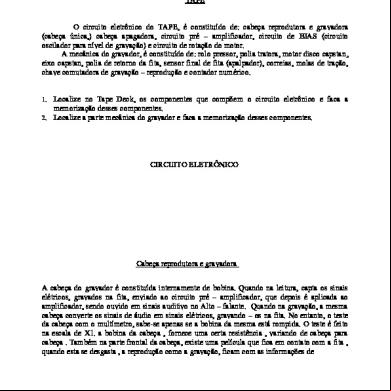Magnetic Tape 1349a
This document was ed by and they confirmed that they have the permission to share it. If you are author or own the copyright of this book, please report to us by using this report form. Report 3b7i
Overview 3e4r5l
& View Magnetic Tape as PDF for free.
More details w3441
- Words: 436
- Pages: 2
Magnetic tape is a long and narrow strip of plastic that thin magnetic material is coated on. Nearly all recording tape is of this type, whether used for recording audio or video or computer data storage. Magnetic tape recording uses magnetic tape which moves on a recording head. Electrical signals are fed to the recording head, inducing a pattern of magnetization similar to the signal. A playback head can then pick up the changes in magnetic field from the tape and convert it into an electrical signal. Devices that record and playback audio and video using magnetic tape are generally called tape recorders and videotape recorders respectively. A device that stores computer data on magnetic tape can be called a tape drive, a tape unit, or a streamer. Autoloaders and tape libraries are frequently used to automate cartridge handling.
History Magnetic tape was first invented for recording sound by Fritz Pfleumer in 1928 in . Pfleumer's invention used an iron oxide(Fe2O3) powder coating on a long strip of paper. Magnetic tape has been used for data storage for over 50 years. In this time, many advances in tape have been made. Modern magnetic tape is most commonly packaged in cartridges and cassettes. Today, many other technologies like CD or DVD are replacing magnetic tape. However, innovation in the technology continues and tape is still widely used.
Strength and Weakness When storing large amounts of data, tape can be cheaper than disk or other data storage options. Tape storage has always been used with large computer systems. Modern usage is a high capacity medium for backups and archives. As of 2008, the highest capacity tape cartridge (Sun StorageTek T10000B) can store 1 TB of data without using compression. But, magnetic tape has quite a long wait time for random accesses since the deck must wind the tape to move from one data to another. (Magnetic tape data storage uses Sequential access method.) Short for Integrated Drive Electronics or IBM Disc Electronics, IDE is more commonly known as ATA or Parallel ATA (PATA). It is a standard interface for IBM compatible hard drives and CD or DVD drives. IDE is different than SCSI and Enhanced Small Device Interface (ESDI) because its controllers are on each drive, meaning the drive can connect directly to the motherboard or controller. IDE and its updated successor, Enhanced IDE (EIDE), are common drive
interfaces found in IBM compatible computers. Below is a picture of the IDE connector on the back of a hard drive, a picture of what an IDE cable looks like, and the IDE channels it connects to on the motherboard.
History Magnetic tape was first invented for recording sound by Fritz Pfleumer in 1928 in . Pfleumer's invention used an iron oxide(Fe2O3) powder coating on a long strip of paper. Magnetic tape has been used for data storage for over 50 years. In this time, many advances in tape have been made. Modern magnetic tape is most commonly packaged in cartridges and cassettes. Today, many other technologies like CD or DVD are replacing magnetic tape. However, innovation in the technology continues and tape is still widely used.
Strength and Weakness When storing large amounts of data, tape can be cheaper than disk or other data storage options. Tape storage has always been used with large computer systems. Modern usage is a high capacity medium for backups and archives. As of 2008, the highest capacity tape cartridge (Sun StorageTek T10000B) can store 1 TB of data without using compression. But, magnetic tape has quite a long wait time for random accesses since the deck must wind the tape to move from one data to another. (Magnetic tape data storage uses Sequential access method.) Short for Integrated Drive Electronics or IBM Disc Electronics, IDE is more commonly known as ATA or Parallel ATA (PATA). It is a standard interface for IBM compatible hard drives and CD or DVD drives. IDE is different than SCSI and Enhanced Small Device Interface (ESDI) because its controllers are on each drive, meaning the drive can connect directly to the motherboard or controller. IDE and its updated successor, Enhanced IDE (EIDE), are common drive
interfaces found in IBM compatible computers. Below is a picture of the IDE connector on the back of a hard drive, a picture of what an IDE cable looks like, and the IDE channels it connects to on the motherboard.





